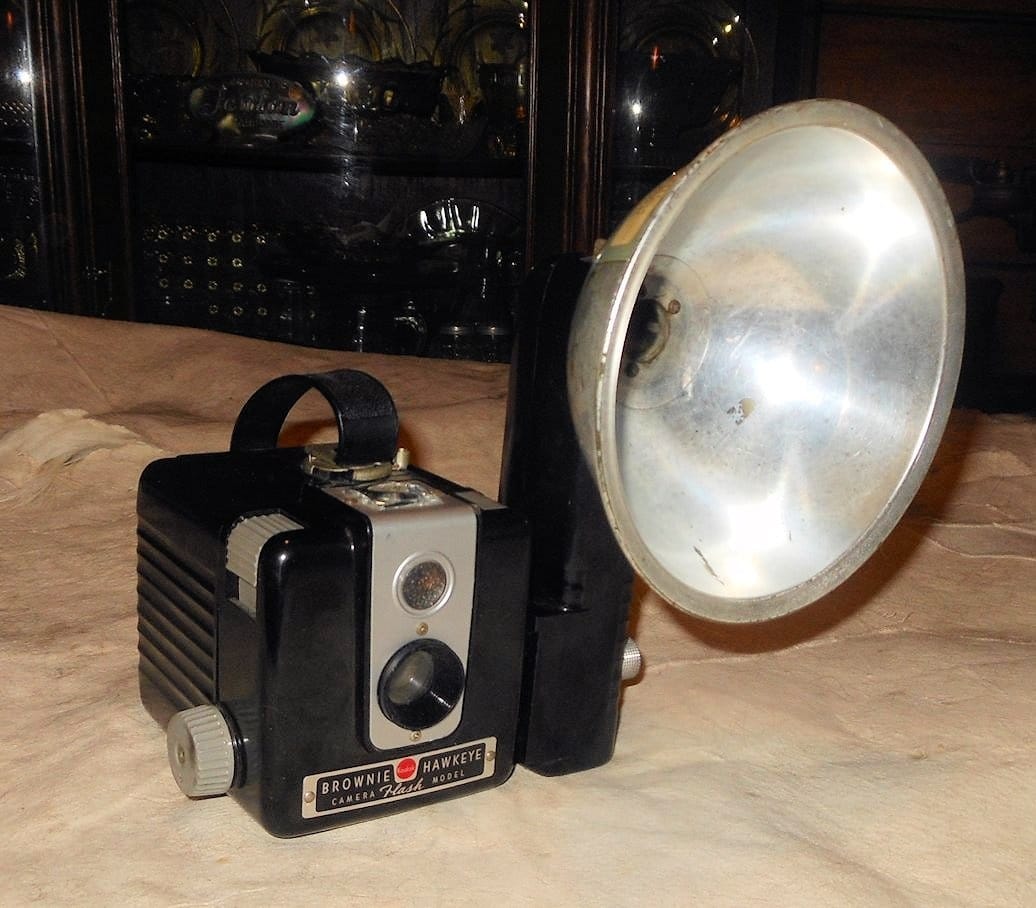Step back in time to 1949, when the Kodak Brownie Hawkeye camera democratized photography, putting it within reach of everyday people. This comprehensive guide explores the Hawkeye’s fascinating history, technical specifications, diverse models, and enduring appeal. Whether you’re a seasoned photographer or a curious beginner, prepare to discover the magic of this vintage gem.
A Closer Look at the Brownie Hawkeye
The Brownie Hawkeye, produced by Kodak from 1949 to 1961, represents a pivotal moment in photographic history. Its simple design and affordability made it a ubiquitous presence in family photo albums for generations, much like the smartphone camera of today. This camera embodies Kodak’s commitment to making photography accessible to everyone, regardless of experience or budget.
Exploring the Hawkeye Family: Models and Variations
The original Brownie Hawkeye, launched in the late 1940s, featured a glass lens and non-synchronized flash, requiring manual flash triggering. Later models introduced plastic lenses and the convenience of synchronized flash, simplifying the capture of spontaneous moments. Interestingly, these cameras used 620 film, a format no longer readily available. However, readily available online resources detail how to adapt more accessible 120 film, likely contributing to the Hawkeye’s continued popularity among film photography enthusiasts.
Mastering Simplicity: Operation
Loading film into a Brownie Hawkeye is remarkably intuitive. The easily opened back and straightforward spool placement make it user-friendly, even for those unfamiliar with film cameras. The controls are equally simple, offering basic settings for effortless point-and-shoot photography. This simplicity was a key factor in the Hawkeye’s historical appeal and continues to be a source of its charm.
Embracing the Soft Focus: Image Quality
The Brownie Hawkeye produces distinctive square format images (approximately 6x6cm). The single-element lens, especially in later plastic lens models, creates a characteristic “soft focus” effect. While some may view this as a limitation, many appreciate the dreamy, nostalgic quality it imparts to photographs, particularly portraits and landscapes. This unique aesthetic distinguishes Hawkeye images from the sharp precision of modern digital cameras.
Illuminating Possibilities: Flash Photography
The aptly named Brownie Hawkeye Flash Model incorporates flash photography, expanding creative possibilities, especially in low-light conditions. This feature, coupled with a compatible flash attachment, can illuminate subjects and preserve moments otherwise lost to darkness. Experimenting with flash can also yield interesting artistic effects, adding another dimension to Hawkeye photography.
A Treasured Legacy: Value and Collectibility
Once commonplace, Brownie Hawkeye cameras are now desirable collectibles. Factors influencing their value include the camera’s condition, model rarity, and the presence of original accessories like the box or flash attachments. Rare variations can command significant prices. If you discover one in your family’s attic, it might be worth more than you think!
Creative Constraints, Artistic Opportunities: Techniques
The Brownie Hawkeye’s limitations, such as its fixed focus and basic lens, can become catalysts for creativity. Experimenting with double exposures, creating surreal layered images, or using long exposures to capture light trails and motion blur can yield unique and artistic results. Even the flash can dramatically influence the mood and aesthetic of images. Embracing these constraints encourages innovative approaches to photography.
A Timeless Icon: Conclusion
The Brownie Hawkeye occupies a unique niche in photographic history. It symbolizes a time when photography prioritized capturing moments over technical perfection. Its simplicity, affordability, and distinctive aesthetic continue to inspire and bridge generations through the shared joy of film photography. The Brownie Hawkeye is more than just a camera; it’s a portal to simpler times and a reminder that beauty can emerge from unexpected places.
Decoding the Brownie Hawkeye: Production Years and FAQs
Acquired a Brownie Hawkeye and wondering about its age? The Brownie Hawkeye was produced from 1949 to 1961. Pinpointing the exact year of manufacture requires a bit of detective work using the four-letter date code inside the camera. This code, when deciphered using the keyword “CAMEROSITY,” reveals the production date, acting like your camera’s birth certificate. Each letter in “CAMEROSITY” represents a number, allowing you to determine the production year by comparing it to the letters in your camera’s code.
The Brownie Hawkeye was manufactured in both the USA and France, adding another layer of intrigue to its history. This detail might subtly influence the camera’s characteristics. Its simple Bakelite construction made it lightweight and durable, and the 6x6cm square format adds a classic charm. Today, the Brownie Hawkeye is a cherished piece of photographic history, treasured by collectors and vintage technology enthusiasts.
Keeping the Brownie Hawkeye Alive: Film Options in 2024
Ready to experience the retro charm of your Brownie Hawkeye? The challenge lies in finding film for this vintage camera. The Hawkeye was designed for 620 film, which is no longer produced. However, several options exist to keep your Hawkeye clicking.
One popular solution is adapting readily available 120 film. Because 620 and 120 film share similar dimensions, you can respool 120 film onto empty 620 spools, or carefully trim the flanges of 120 spools. These methods, while requiring some care and precision, enable the use of currently available films in your Hawkeye.
Another exciting prospect is the Hawkeye35 adapter kit, currently under development. This kit promises seamless 35mm film compatibility, simplifying the film-loading process. While a release date is yet to be confirmed, this project signifies a continued interest in reviving these classic cameras.
The Brownie Hawkeye produces charming 6x6cm square images with a vintage aesthetic, thanks to its fixed-focus lens. While best suited for bright outdoor conditions, it’s a fantastic entry point into the unique world of film photography.
Whether you choose to adapt 120 film or anticipate the Hawkeye35 adapter, numerous options exist to keep your Brownie Hawkeye capturing memories. Each method offers its advantages and challenges, but the process itself connects you with the tangible and rewarding experience of vintage photography.
Breathing New Life into Your Brownie: A Guide to Using Vintage Kodak Brownie Cameras
Yes, you can absolutely still use a vintage Brownie camera! These cameras, especially the Hawkeye models, retain much of their original charm and functionality. While designed for the now-discontinued 620 film, resourceful photographers have devised methods to keep these vintage gems clicking.
Here are a few ways to bring your Brownie back to life:
Respooling: This method involves carefully transferring 120 film onto empty 620 spools in a dark environment. It requires patience and precision but is a popular method for using readily available film.
Trimming: Another option is to trim the flanges of 120 film spools to fit the narrower 620 spool size. This method, while quicker, requires even more precision to avoid damaging the film.
35mm Adapter (Future Potential): The Hawkeye35 adapter kit, still under development, promises to simplify the process by enabling the use of widely available 35mm film.
Shooting with a Brownie Hawkeye is a unique experience, distinct from modern digital photography:
Fixed Focus: The Hawkeye’s fixed-focus lens requires careful consideration of subject distance and composition.
Vintage Aesthetic: The simple lens and film format create images with a characteristic soft focus, sometimes vignetting, and occasional light leaks. These “imperfections” contribute to the Hawkeye’s vintage charm.
Creative Freedom: The Brownie Hawkeye’s limitations encourage experimentation with double exposures, long exposures, and creative framing.
Beyond the technical aspects, using a Brownie Hawkeye connects you with the history of photography, offering a mindful approach in a fast-paced digital world. The limited number of exposures per roll encourages thoughtful composition and a deeper appreciation for the process.
The enthralling cocktail of bourbon lemon and mint crossword can leave you flabbergasted, striving to solve each cryptic clue. In need of a crockery set that can create a striking contrast in your dining room? Look no further than the exquisite blue willow pattern crockery.
- Unlock Water’s Symbolism: A Cross-Cultural Exploration - April 20, 2025
- Identify Black and White Snakes: Venomous or Harmless? - April 20, 2025
- Unlocking Potential: Origins High School’s NYC Story - April 20, 2025
















1 thought on “The Kodak Brownie Hawkeye Camera: A Comprehensive Guide to History, Use, and Value”
Comments are closed.